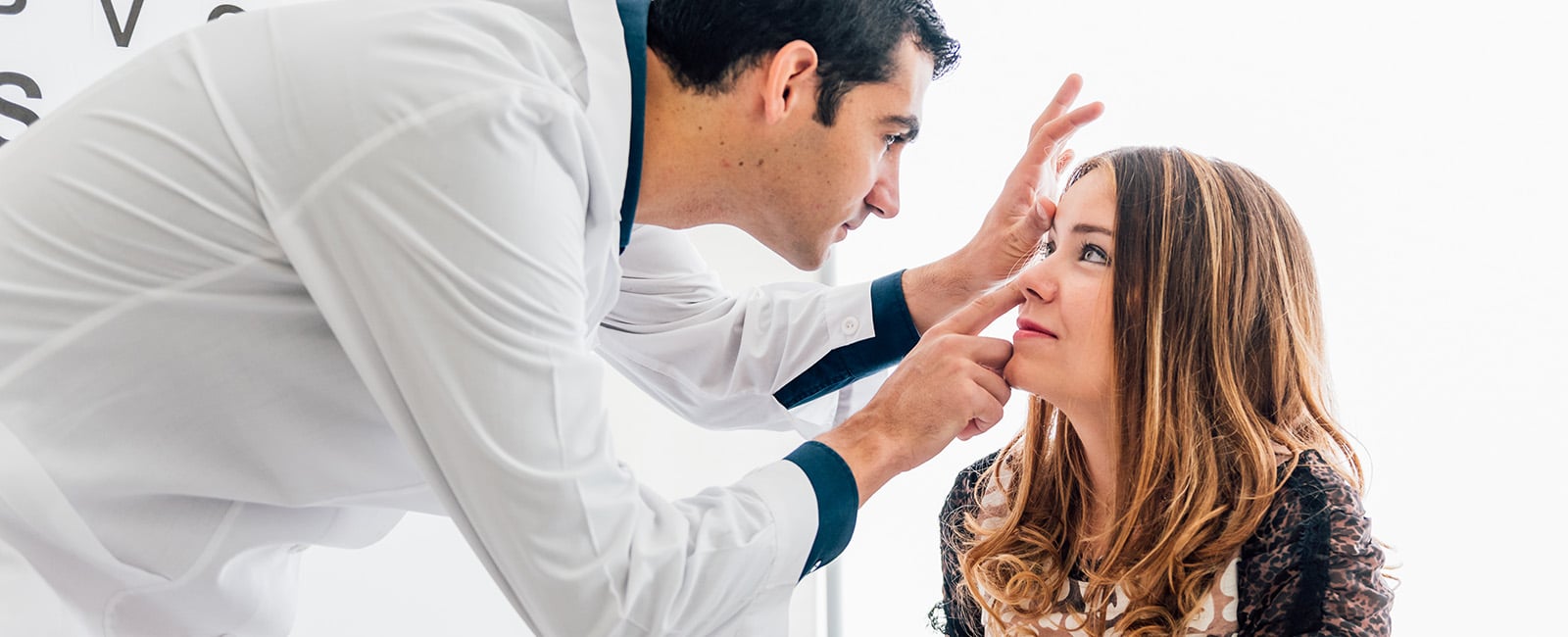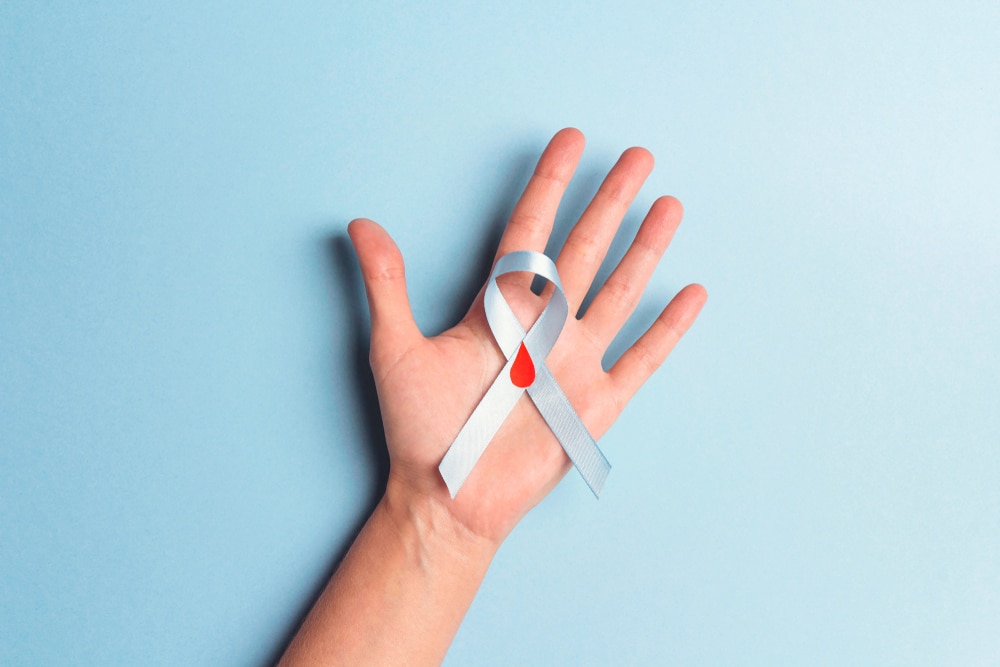Medically Reviewed by:
How Does Diabetes Affect the Eyes?
Understanding Diabetes and Eye Care
How does diabetes affect the eyes? Can diabetes damage your eyes and lead to blurry vision or other long term eye complications? What about treatment – is eye damage from diabetes reversible?
Whether you’ve had diabetes for years, have just been diagnosed, or are simply doing some investigating into future health concerns, questions like these are bound to cross your mind. Diabetes can cause several complications with your vision, which may start to show up as diabetic eye disease symptoms. These complications can be short term and temporary or long term and very problematic.
Long story short, diabetes can and often does negatively impact your eyes. In fact, blurry vision can sometimes be a warning sign that a diabetes diagnosis may be on the horizon. Learn the basics of diabetes and eye care covered below, then call the trusted ophthalmologists at Eye Center of Texas for more information.
How does high blood sugar affect your eyes?
When you ask the question “How does diabetes affect the eyes?” you simply can’t get very far into an answer without stumbling upon the role of blood sugar.
When you suffer from high (or even low) blood sugar, you may experience short term blurriness. Once you’re able to get your blood sugar levels back under control, your blurry vision may start to clear up. In these instances, when the damage to your eyes isn’t permanent, patients may see a reversal in symptoms.
Health note: Diabetes can lead to cataracts. Learn more about fast-growing cataracts and what the early signs of cataracts are.
Eye care and diabetic retinopathy
Diabetic retinopathy occurs when the blood vessels in your eyes are damaged permanently due to uncontrolled diabetes. If left unchecked, vision symptoms and issues caused by diabetic retinopathy will become worse over time.
Diabetic eye disease symptoms often include:
- Floaters
- Blurry vision
- Vision loss
- Dark areas
- Poor night vision
- Impaired color vision
For more information regarding diabetic retinopathy, read our articles regarding your diabetic retinopathy diagnosis, the four stages of diabetic retinopathy, and foods to eat for diabetic retinopathy and eye health.
Have diabetes? Experiencing blurry vision? Eye Center of Texas can help.
The answer to “How does diabetes affect the eyes” isn’t a straightforward one. As we mentioned previously, diabetes-related blurry vision can be temporary, a sign of diabetic retinopathy, or even a symptom of other issues aside from diabetes.
If you have diabetes and have noticed a sudden or gradual increase of blurry vision, it’s time to check in with your eye doctor at Eye Center of Texas. When it comes to your vision, it’s best to play it safe, and that’s especially true if you have diabetes.
For some of the best eye care in Houston, visit a leading ophthalmologist at Eye Center of Texas. Request an appointment online or give us a call at 713-797-1010 today
Other Helpful Articles by Eye Center of Texas:
Related Articles
Medically Reviewed by:
Diabetic Retinopathy & The Best Foods for Eye Health
Patients who have been diagnosed with diabetes and are concerned about diabetic retinopathy often ask the ophthalmologists at Eye Center of Texas about the best foods for eye health. Often, the foods that are good for your eyes are good for the rest of your body as well, but there are some foods that may be especially good for the health of your eyes. Learn which foods you should put on your next grocery list if you want to “eat for your eyes.”
Foods good for your eyes, brain, and body
What can you eat to improve your eyesight? Which fruit is good for eyes? Are nuts good for your eyes? What is the best vitamin for eyes? And minerals — which minerals are good for eyes?
If you’ve started looking into the best foods for eye health, these are the types of questions you’re likely asking. We’ve compiled a list of whole foods, vitamins, and minerals that have been found to promote healthier eyesight.
Vitamins and minerals: The following vitamins and minerals have high concentrations of antioxidants such as lutein and zeaxanthin, which are believed to help absorb blue light — the type of sunlight that causes damage to your retina. Next to each of these is a list of common fruits, vegetables, nuts, seeds, and legumes high in that particular vitamin/mineral (For a brush-up on the types of vitamins and what they do, we recommend Harvard’s list of vitamins).
Vitamin A
Vegetables: Sweet potato, collard greens, turnip greens, kale, Swiss chard, spinach, romaine, squash, carrot, red pepper, and salmon
Fruit: Mango, cantaloupe, watermelon, grapefruit, and papaya
Vitamin C
Vegetables: Broccoli, spinach, kale, Brussel sprouts, cauliflower, sweet potatoes, winter squash
Fruit: Oranges, lemons, grapefruit, cantaloupe, strawberries, kiwi, chili peppers, yellow pepper, and guava
Vitamin E
Vegetables: Butternut squash, spinach, Swiss chard, and turnip greens
Fruit: Avocado, sweet red pepper, mango, and kiwi
Nuts & seeds: Hazelnuts, pine nuts, peanuts, almonds, brazil nuts, and sunflower seeds
Zinc
Vegetables: Peas, spinach, broccoli, okra, asparagus, shiitake mushrooms
Fruit: Cantaloupe, avocado, apricot. guava, blackberries, raspberries, blueberries, and kiwi
Nuts, seeds, legumes: Cashews, pecans, chia seeds, pumpkin seeds, flax seeds, brazil nuts, almonds, lima beans, and chickpeas
Omega-3 fatty acids, found in salmon, sardines, walnuts, soybeans, yogurt, and flaxseed have also been shown to help maintain healthy eyesight.
If I have diabetic retinopathy, how can I improve my vision naturally?
A few of the top eye health tips we can give you have nothing to do with the best foods for eye health. If you haven’t already, start exploring questions like, “What are the four stages of diabetic retinopathy?” and identify the steps you can take toward preventative eye-care, such as learning how to protect your eyes in summer.
Our second (and arguably more important) tip is to know when to seek out natural remedies vs. when to see an eye doctor. If you have diabetes and have not started searching for a “diabetic retinopathy eye doctor near me,” we recommend doing so as soon as possible.
Keep your eyes healthy at Eye Center of Texas
Eating foods that are good for your eyes is a great step toward achieving better eye health. But for those with diabetes, eating good food, even if it’s only the best foods for eye health, is only part of a comprehensive plan for taking care of your eyes.
The trained ophthalmologists at Eye Center of Texas can help spot and treat eye issues, including diabetic retinopathy, diabetes-related fast-growing cataracts, macular degeneration, cataracts, and more. Over 275 doctors in Houston refer their patients to Eye Center of Texas, home to some of the best LASIK and cataract surgeons in the country.
To request an appointment with one of our esteemed doctors, call 713-797-1010 or contact us online today.
Other Helpful Blogs from Eye Center of Texas:
- Difference Between Optometrist and Ophthalmologist
- Student Chronicles LASIK Experience
- Can Cataract Surgery Be Done on Both Eyes at Once?
- How Many Times Can You Have LASIK?
- How to Take Care of Someone After LASIK
Related Articles
Medically Reviewed by:
What are the Four Stages of Diabetic Retinopathy?
Diabetic retinopathy is a type of diabetic eye disease that can cause vision problems and eventually, blindness. If you or a loved one has recently been diagnosed with diabetic retinopathy, you were likely informed that the disease progresses through four stages.
Exactly what are the four stages of diabetic retinopathy? In what way are they connected to the causes and symptoms of diabetic retinopathy? And is there any way to slow the progression of diabetic retinopathy through treatment?
Eye Center of Texas is an expert on diabetic eye diseases, including diabetic retinopathy, diabetic macular edema (DME), and fast-growing cataracts. Together, we’ll explore the answers to these questions and more below.
The four stages of diabetic retinopathy
Diabetic retinopathy is caused by an excess of blood glucose in the blood vessels of the retina. The quickest way to know the answer to the question, “What are the four stages of diabetic retinopathy?” is to track the status of these blood vessels.
Stage 1: Mild nonproliferative retinopathy — microaneurysms
What is the first sign of diabetic retinopathy? Microaneurysms — dilated capillaries which look like a small red dot or balloon — are often the first sign of diabetic retinopathy. However, microaneurysms do not affect vision and often go unnoticed as a result.
Stage 2: Moderate nonproliferative retinopathy — blocked blood vessels
In this stage, the blood vessels in the eye become too swollen to properly provide nourishment to the retina. These changes often cause visible changes to the retina. An increased likelihood of DME is associated with patients who reach this stage of diabetic retinopathy. (Read more about DME and macular puckers on our blog.)
Stage 3: Severe nonproliferative retinopathy — more blocked blood vessels & a call for help
At this stage, a significant portion of the blood vessels in your retina are now blocked, severely decreasing the necessary blood flow to the retina. Eventually, the retina will begin to send out signals, telling the body to grow new blood vessels.
Stage 4: Proliferative retinopathy — blood vessels grow on the retina
Stage four diabetic retinopathy is the most advanced stage of diabetic retinopathy, during which new blood vessels begin to grow on the retina. Unfortunately, these blood vessels are typically both weak and abnormal, which can lead to blood leaking into the eye, vision problems, and potentially blindness.
Diabetic retinopathy complications:
Besides vision loss and blindness, untreated diabetic retinopathy can lead to even more complications. These complications can include glaucoma — pressure in the eye due to a buildup of fluid — and retinal detachment — the pulling away of the retina from the back of the eye due to scar tissue buildup.
Diabetic retinopathy treatment & prevention:
The question about diabetic retinopathy we most often hear after, “What are the four stages of diabetic retinopathy?” is, “Is diabetic retinopathy reversible or treatable?”
While diabetic retinopathy is not reversible, it is highly treatable. Active, regular, and proper management of your diabetes, blood sugar, and blood pressure can significantly reduce the chances of experiencing blindness.
Many patients are also eligible for diabetic retinopathy surgery. Called laser photocoagulation, this procedure can be performed in-office in less than 30 minutes. During the procedure, a laser is used to target leaking blood vessels, sealing them or destroying them before they can cause further vision problems.
Stage 0: Talk with an eye specialist about diabetic retinopathy
The sooner diabetic retinopathy is caught and diagnosed, the better your body will respond to treatment. If you or a loved one has been diagnosed with diabetes, it is wise to routinely consult with an expert at Eye Center of Texas to check for any signs of diabetic eye disease.
While there, you can also ask other vision-related questions, such as “Now that I have diabetes, is my vision too bad for LASIK?” and receive answers from the experts who provide some of the best LASIK in Houston.
Diabetes doesn’t have to lead to blindness. Make Eye Center of Texas part of your vision of the future. To meet with one of our doctors at our six Houston-area locations, call us at 713-797-1010 or request an appointment online today.
Related Resources:
Related Articles
Medically Reviewed by:
Diabetic Vision Loss: Preventative Steps & Treatments
Living with diabetes is tough. You have to check your blood sugar, adjust your diet, a monitor other additional or potential health complications. Eye health is one of these potential health complications, and one to which both type 1 and type 2 diabetics should pay special attention. Diabetes is the leading cause of vision loss for people under age 74, but there are steps you can take to better manage your eye health.
(more…)
Related Articles
Medically Reviewed by:
Do you have Pre Diabetes?
An estimated 86 million Americans, that’s one in three adults have prediabetes, and nearly 90 percent of them don’t know it. The good news is that prediabetes can be easy to diagnose and can be reversed with diet and exercise.
Tomorrow, March 22, 2016 is Prediabetes Alert Day and The American Diabetes Association is asking Americans to learn where they stand with prediabetes, a condition that can lead to type 2 diabetes.
- Tune in to or record The Dr. Oz Show on Tuesday, March 22, for a program about prediabetes and ways to lower your risk for developing type 2 diabetes.
- Visit DoIHavePrediabetes.org. Take the one-minute risk test and encourage everyone you know to take it, too. A score of 5 or higher means you should talk to your doctor.
Eye Complications due to Diabetes:
People with diabetes do have a higher risk of blindness than people without diabetes. But most people who have diabetes have nothing more than minor eye disorders. With regular checkups, you can keep minor problems minor. And if you do develop a major problem, there are treatments that often work well if you begin them right away.
Eye Center of Texas has 2 ophthalmologist who specialize in diabetic retinopathy: Dr. Ting-Fang Suarez and Dr. Paul Stewart. They would like everyone with prediabetes and diabetes to know that the longer you’ve had diabetes, the more likely you are to have diabetic retinopathy. Almost everyone with type 1 diabetes will eventually have nonproliferative retinopathy. And most people with type 2 diabetes will also get it. But the retinopathy that destroys vision, proliferative retinopathy, is far less common. People who keep their blood sugar levels closer to normal are less likely to have retinopathy or to have milder forms.
Your retina can be badly damaged before you notice any change in vision. Most people with nonproliferative retinopathy have no symptoms. Even with proliferative retinopathy, the more dangerous form, people sometimes have no symptoms until it is too late to treat them. For this reason, you should have your eyes examined regularly by an eye care professional.
Stay at a healthy weight, eat well and be active. With these steps, you can stay healthier longer and lower your risk of diabetes.
Related Articles
Medically Reviewed by:
Diabetes and Long Term Eye Damage
High blood sugar can damage the tiny blood vessels that bring oxygen and nutrients to the retina, a critical part of the eye. This is known as diabetic retinopathy, and it can cause progressive, irreversible vision loss. It is the leading cause of new cases of blindness in people between the ages of 20 and 74.
And get this…people with Diabetic-Retinopathy will increase 47% from 2010 to 2030? Our doctors advise patients with diabetes to take an active diligent role in preventing vision loss from diabetic eye disease problems with regular dilated eye exams and health lifestyle choices.
Related Articles
Medically Reviewed by:
November is National Diabetes Awareness Month
Diabetes is one of the leading causes of disability and death in the United States. If it’s not controlled, diabetes can cause blindness, nerve damage, kidney disease, and other health problems.
Here are just a few of the recent statistics on diabetes:
Nearly 30 million children and adults in the United States have diabetes.
Another 86 million Americans have prediabetes and are at risk for developing type 2 diabetes.
The American Diabetes Association estimates the total national cost of diagnosed diabetes in the United States is $245 billion.
Our doctors advise patients with diabetes to take an active diligent role in preventing vision loss from diabetic eye disease problems with regular dilated eye exams and health lifestyle choices.
Related Articles
Financing Options Available
Apply today to find a financing option that meets your needs.
Our Locations
Houston/Bellaire
6565 W. Loop S., Suite 650Bellaire, TX 77401
Medical Office:
713-797-1010
Medical Fax:
713-357-7276
LASIK/Near Vision:
Office: 713-395-1515
Fax: 713-357-7278
Pasadena
4415 Crenshaw RoadPasadena, TX 77504
Medical Office:
281-977-8800
Medical Fax:
281-977-8877
Sugar Land
15200 S.W. Freeway, Suite 130Sugar Land, TX 77478
Medical Office:
281-277-1010
Medical Fax:
281-277-4504
Clear Lake
455 E. Medical Center Blvd., Suite 110Webster, TX 77598
Medical Office:
281-332-1397
Medical Fax:
281-282-9152
Katy
Greenhouse Medical Plaza2051 Greenhouse Road, Suite 110
Houston, TX 77084
Medical Office:
346-547-7070
Medical Fax:
281-214-2971
The Woodlands/Conroe
100 Medical Center Blvd., Suite 118Conroe, TX 77304
Medical Office:
936-647-1610
Medical Fax:
936-647-1620



